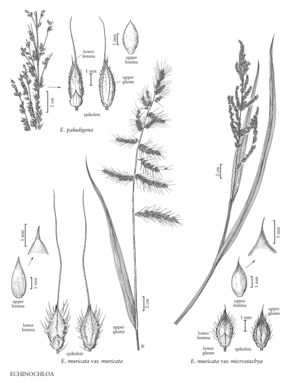Echinochloa paludigena
Plants annual. Culms to 150 cm, erect. Sheaths glabrous; ligules absent; blades 15-60 cm long, 8-20 mm wide, scabrous adaxially. Panicles 8-40 cm, erect to slightly drooping, rachis nodes hispid, hairs papillose-based; primary branches 2-19 cm, erect to spreading, often widely spaced, longer branches with secondary branching. Spikelets 3.3-4.5 mm long, 2.4-2.6 mm wide, disarticulating at maturity, greenish or purplish, scabrous and hispid, hairs to 1 mm, often papillose-based. Upper glumes about as long as the spikelets; lower florets staminate; lower lemmas usually awned, awns 1-15 mm, purplish; lower paleas well-developed; upper lemmas broadly ovate, narrowing abruptly to the acute or acuminate apices; anthers of upper florets 1.2-1.7 mm. Caryopses 1.5-1.8 mm. 2n = unknown.
Discussion
Echinochloa paludigena is native to swamps, river-banks, and other wet habitats. Reports from Texas and Louisiana appear to be based on misidentifications; Wunderlin (1988) considers E. paludigena as a Florida endemic.
Selected References
None.
Lower Taxa
"decumbent" is not a number.
